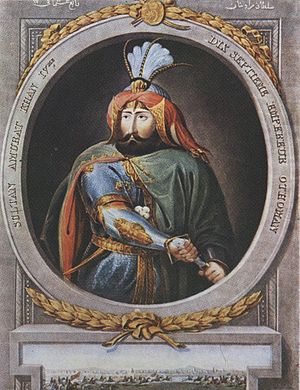Capture of Baghdad (1638)
| Siege of Baghdad (1638) | |||||||||
|---|---|---|---|---|---|---|---|---|---|
| Part of Ottoman–Safavid War (1623–1639) | |||||||||
 Portrait of Murad IV |
|||||||||
|
|||||||||
| Belligerents | |||||||||
|
|
|
||||||||
| Commanders and leaders | |||||||||
|
|
|
||||||||
| Strength | |||||||||
| 40,000 infantry 211 fortified city towers 100 cannons |
35,000 infantry 73,000 cavalry 200 cannons not in combat: 8,000 (lağımcı) miners and sappers 24,000 (beldar) military laborers |
||||||||
| Casualties and losses | |||||||||
| entire garrison | High | ||||||||
| High | |||||||||
Capture of Baghdad refers to the second conquest of the city by the Ottoman Empire as a part of the Ottoman–Safavid War (1623–39).
Baghdad (capital of modern Iraq), once the capital of Arab Abbasid Caliphate, was one of the most important cities of the Muslim World. In the second half of the Medieval age, Turkic rulers (Seljuks, Kara Koyunlu, Ak Koyunlu) as well as others always tried to control this prestigious city. From 1508 till 1534 it was ruled by the emerging Safavid dynasty of Iran, between that time led by shah Ismail I and shah Tahmasp I respectively. In 1534, Ottoman sultan Suleyman I (also known as Suleyman the Magnificent) captured the city without any serious combat during the Ottoman–Safavid War (1532–55), which got confirmed in the resulting Peace of Amasya. However, 90 years later it was recaptured by Abbas I of Persia (also known as Abbas the Great).
Attempts of several Ottoman commanders (Turkish: serdar) to retake the city following 1624, were fruitless. According to a legend only the sultans could capture the city. Murat was seen as a warrior hero and thus it seemed as his duty to campaign and regain Baghdad. He had been victorious against the Druze rebels a decade earlier and won a great victory at the Siege of Yerevan in 1635. In 1638 Ottoman Sultan Murat IV (five generation younger than Suleyman I) decided to recapture the city.
...
Wikipedia
